Chapter: Engineering Mechanics : Friction and Elements of Rigid Body Dynamics
Friction and Elements of Rigid Body Dynamics
FRICTION AND ELEMENTS OF RIGID BODY DYNAMICS
1
Friction
1.1
Explanation
2 Types
of Friction
2.1
Static Friction
2.2
Dynamic Friction
3
Limiting Friction
4 Normal
Reaction
5 Co
Efficient of Friction
6 Laws of
Friction
6.1 Laws
of Static Friction
6.2 Laws
of Dynamic Friction
1 Friction
A force
which prevents the motion or movement of the body is called friction or force
of friction and its direction is opposite to the applied external force or
motion of the body. Friction is a force of resistance acting on a body which
prevents or retards motion of the body. Or When a body slides upon another
body, the property due to which the motion of one relative to the other is
retarded is called friction. This force always acts tangent to the surface at
points of contact with other body and is directed opposite to the motion of the
body.
1.1 Explanation
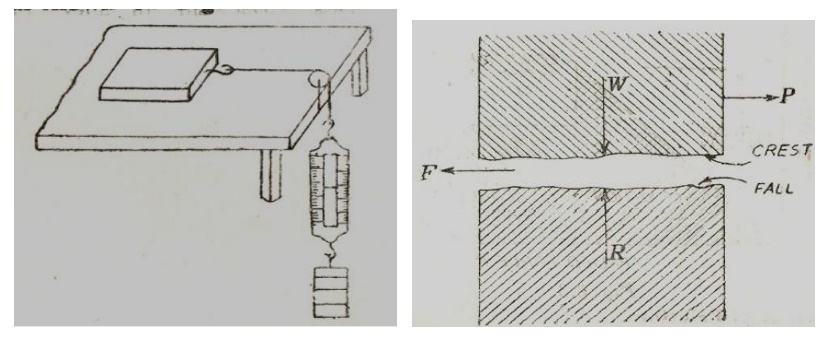
The other
end of the string is connected to the spring balance. Apply an external force
on the balance. Gradually increase the magnitude of the external force.
Initially the body will not move and the effect of the applied force is
nullified. This is because there acts a force on the block which opposes the
motion or movement of the block. The nature of this opposing force is called
friction. It depends upon many factors. The major cause of friction is the
microscopic roughness of the contact surfaces. No surface is perfectly smooth.
Every surface is composed of crests and falls as shown in fig b. It is the
interlockingof the crests of one surface into the falls of the other surface
which produces the resistance against the movement of one body over the other
body. When the force exerted is sufficient to overcome the friction, the
movement ensures and the crests are being sheared off. This gives rise to heat
and raises the local temperature. This is also the reason of the wear of the
contact surfaces. This phenomenon of friction necessitates the presence o fluid
film between the two surfaces to avoid wear of surfaces. The process of
creating the fluid film is called lubrication
2 Types of Friction
Friction
is of the following two types.
5.2.1 Static Friction
It is the
friction acting on the body when the body is at the state of rest or the
friction called into play before the body tends to move on the surface is
called static friction. The magnitude of the static friction is equal to the
applied force. It varies from zero to maximum until the movement ensures.
2.2 Dynamic Friction
It is the
friction acting on the body when body is in motion is called dynamic friction.
Dynamic friction is also known as kinetic friction. The magnitude of the
dynamic friction is constant.
The
dynamic friction has two types
i.
Sliding Friction
ii.
ii. Rolling Friction
i. Sliding friction
The
sliding friction acts on those bodies, which slide over each other for example
the friction between piston, and cylinder will slide friction because the
motion of the motion of the piston in cylinder is sliding and there is surface
contact between piston and cylinder.
ii. Rolling Friction
The
rolling friction acts on those bodies which have point contact with each other
for example the motion of the wheel on the railway track is the example of
rolling motion and the friction between the wheel and railway track is rolling
friction. It is experimentally found that the magnitude of the sliding friction
is more than the rolling friction because
in the
rolling friction there is a point contact rather than surface contact.
3 Limiting Friction
The
maximum friction (before the movement of body) which can be produced by the
surfaces in contact is known as limiting friction .It is experimentally found
that friction directly varies as the applied force until the movement produces
in the body.
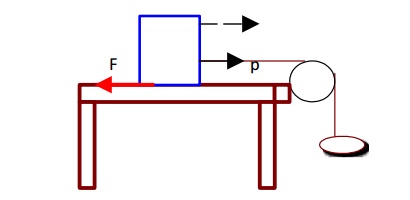
Let us
try to slide a body of weight w over another body by a force P as shown in fig
A little
consideration will show that the body will not move because the friction F
which prevents the motion. It shows that the applied force P is exactly
balanced by the force of friction acting in the opposite direction of applied
force P. if we increase the force P by increasing the weight in the pan, the
friction F will adjust itself according to applied force P and the body will
not move. Thus the force of friction has a property of adjusting its magnitude
to become exactly equal and opposite to the applied force which tends to
produce the motion.There is however a limit beyond which the friction cannot
increase. If the applied force increases this limit the force of friction
cannot balance applied force and body begins to move in the direction of
applied force. This maximum value of friction, which acts on body just begin to
move, is known as limiting friction. It may be noted that when the applied
force is less than the limiting friction the body remains at rest, and the friction
is called static friction, which may have any values zero to limiting friction.
4 Normal Reaction
Let us
consider a body A of weight “W” rest over another surface B and a force P
acting on the body to slide the body on the surface B as shown in fig
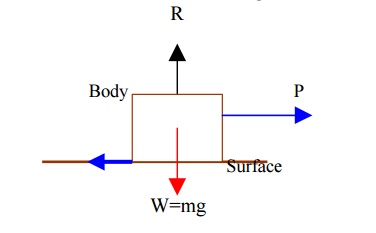
A little
concentration will show that the body A presses the surface B downward equal to
weight of the body and in reaction surface B lift the body in upward direction
of the same magnitude but in opposite direction therefore the body in
equilibrium this upward reaction is termed as normal reaction and it is denoted
by R or N.
Note
It is
noted the weight W is not always perpendicular to the surface of contact and
hence normal reaction R is not equal to the weight W of body in such a case the
normal reaction is equal to the component of weight perpendicular to surface.
5 Co Efficient of Friction
The ratio
of limiting friction and normal reaction is called coefficient of friction and
is denoted by μ.
Let R =
normal reaction
And F =
force of friction (limiting friction)
μ = Co
efficient of friction F/R = μ
F = μ R
6 Laws of Friction
These
laws are listed below:
6.1 Laws of Static Friction
The force
of friction always acts in a direction opposite to that in which the body tends
to move.
·
The magnitude of force of static friction is just
sufficient to prevent a body from moving and it is equal to the applied force.
·
The force of static friction does not depend upon,
shape, area, volume, size etc. as long as normal reaction remains the same.
·
The limiting force of friction bears a constant
ratio to normal reaction and this constant ratio is called coefficient of
static friction.
6.2 Laws of Dynamic Friction
·
When a body is moving with certain velocity, it is
opposed by a force called force of dynamic friction.
·
The force of dynamic friction comes into play
during the motion of the body and as soon as the body stops, the force of
friction disappears.
·
The force of dynamic friction is independent of
area, volume, shape, size etc. of the body so long the normal reaction remains
the same. However, to some extent it varies with the magnitude of
·
velocity of the body. Force of dynamic friction is
high for low speeds and low for very high speeds.
·
The ratio of force of dynamic friction and normal
reaction on the body is called coefficient of dynamic friction.
Example 1: A horse exerts a pull of 3 KN just to
move a carriage having a mass of 800 kg. Determine the co efficient of friction
between the wheel and the ground. Take g = 10 m/sec²
Given P = 3 KN Mass = m = 800 Kg g = 10
m/sec²
Required co efficient of friction = μ =?
Working formula F = μ R
Solution we know that W = mg
W = 800 x
10 = 8000 N
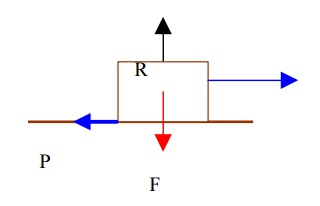
A little
consideration will show that the weight of the carriage is equal to the normal
reaction because that the body is horizontal to the plane as shown in fig
Therefore
W = R and P = F
put the
values in working formula we get
300 = μ
8000 μ =0.375
Result co efficient of friction = 0.375
Example 2: A pull of 490 N inclined at 30º to the
horizontal is necessary to move a block of wood on a horizontal table. If the
coefficient of friction between to bodies in contact is 0.2 what is the mass of
the block.
Given P = 490 N θ = 30º μ = 0.2
Required mass of block =?
Solution
Now
consider the following diagram and also resolve the force P into horizontal and
vertical components.
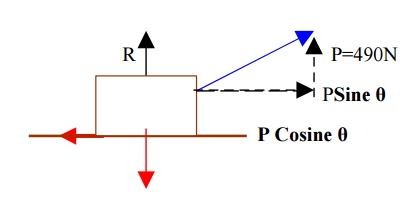
F = μ R w = mg
Now apply
the condition of equilibrium the forces acting in x axis is positive
Σ Fx = 0
P Cosine
θ – F = 0
P Cosine
θ – μ R = 0
490
Cosine 30– 0.2 x R = 0 Therefore
R = 2121.762
Now
consider the forces acting in y axis is positive
Σ Fy= 0
R + P
Sine θ – W = 0 R + P Sine θ – mg = 0
2121.762
+ 490 Sine 30– m x 9.81 = 0
m =
241.260 Kg
Result mass of the wooden block = 241.260 Kg
Example 3: A body of mass 100 Kg rests on
horizontal plane the co efficient of friction between body and the plane 0.40.
Find the work done in moving the body through a distance of 20 m along the
plane.
Given m = 100 Kg μ = 0.40 d = 20 m
Required work done =?
Working formula 1 W = F x d
2 Fs = μ
R
Solution we know that R = W = mg R = W = 10 x 9.81 = 98.1 N
Put the
values in 2nd working formula we get Fs = 0.40 x 98.1
Fs =
39.24 N
Now put
the values in 1st working formula W = 39.24 x 20
W = 748.8
N
Resultant weight = 748.8 N
Related Topics